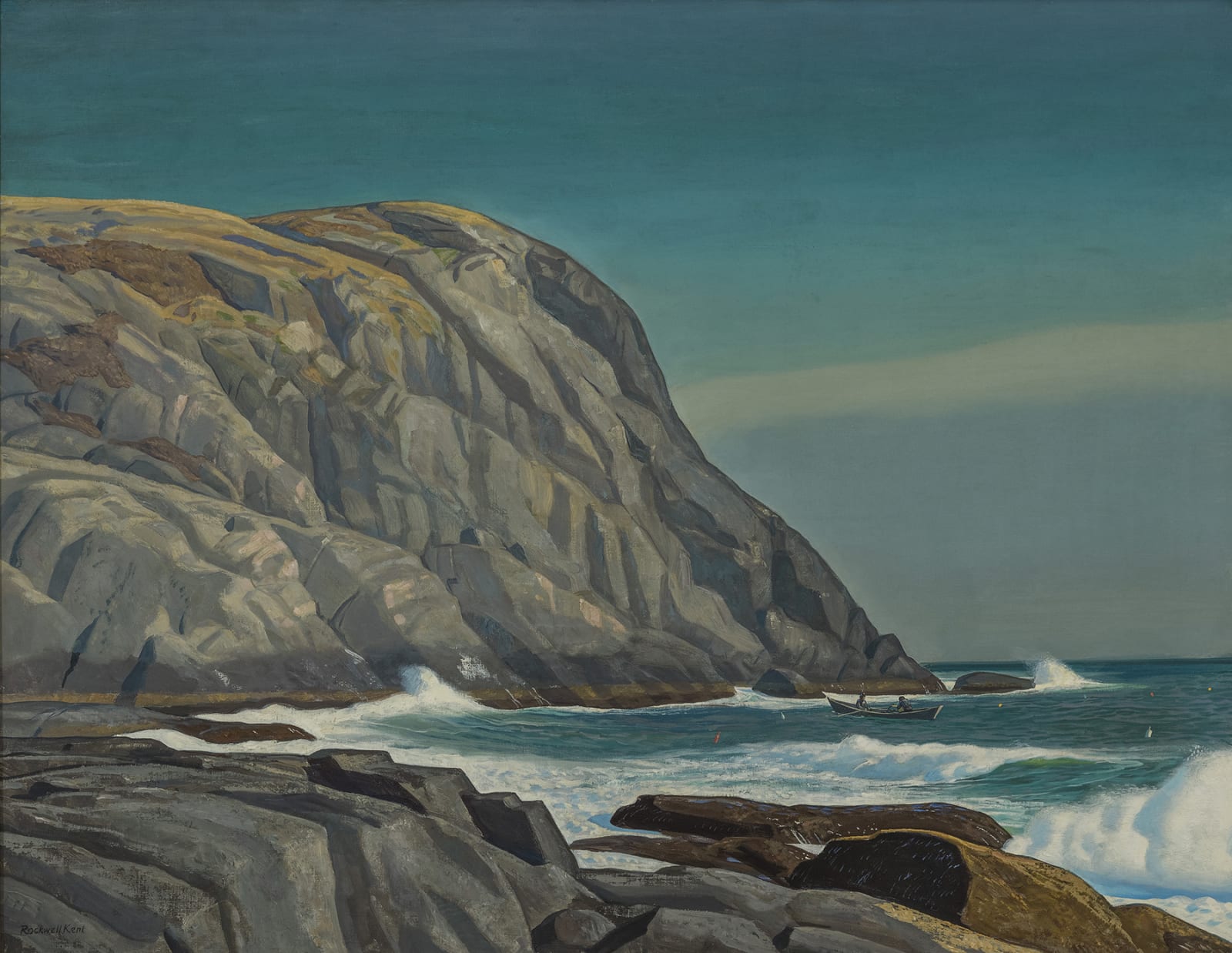Rockwell Kent American, 1882-1971
Whitehead (Monhegan), c. 1947
Oil on canvas
34 x 44 inches
Rockwell Kent’s first experience with Maine came at age 23, when, under the influence of Robert Henri, he visited Monhegan. The place is more wonderful & beautiful than you told...
Rockwell Kent’s first experience with Maine came at age 23, when, under the influence of Robert Henri, he visited Monhegan.
The place is more wonderful & beautiful than you told me it was,
he wrote his teacher. “I’ve been here almost three weeks and haven’t gotten over my amazement yet. It seems to me now that I’d like to paint here always. I could sit all day in some of those holes under the headlands, watching the water & scared to deather. I’ve never been such terrible places as some of those crevases [sic].” [As quoted by Jake Milgram Wien, Rockwell Kent: The Mythic and the Modern (2005).
Despite that commitment to “paint here always,” he did lapse in his practice of observing, in a Henri-esque manner, the “windblown ocean plain . . . dark as indigo to a horizon knife-sharp against the golden lower sky” [Ibid.]. He completed two major canvases of the same subject as the present work – including Maine Headlands (1907), and Headlands and Sea (1910) – before being bitten by a the modernist bug, in 1913. The occasion of the Armory Show brought the many streams of European modernism raging to the fore of American consciousness, and Kent was washed away in the torrent. His dealer, Charles Daniel, pushed him further in this direction, and the years immediately following the watershed exhibition found the painter exploring symbolist and other avant garde techniques in his treatment of the landscape.
Trips to Newfoundland, and, a few years later, Alaska, rekindled in Kent the love of that “knife-sharp” blue-and-white terrain, and 1919-20 saw a return of this manner of painting, even alongside his symbolist fantasies—but Kent’s most powerful body of work meditating on these subjects didn’t come until the mid-1930s. He returned to Maine in the late 1940s, re-purchasing a house he had previously owned, in 1948, producing a body of paintings there from 1947-53.
The present work treats a subject – “Maine headlands”—that helped established his early and lasting vision. While we cannot discount the possibility that this was painted in his first trip there, most likely it was painted in that last period, 1947-53, when he lived and worked there in full control of his painterly powers.
The place is more wonderful & beautiful than you told me it was,
he wrote his teacher. “I’ve been here almost three weeks and haven’t gotten over my amazement yet. It seems to me now that I’d like to paint here always. I could sit all day in some of those holes under the headlands, watching the water & scared to deather. I’ve never been such terrible places as some of those crevases [sic].” [As quoted by Jake Milgram Wien, Rockwell Kent: The Mythic and the Modern (2005).
Despite that commitment to “paint here always,” he did lapse in his practice of observing, in a Henri-esque manner, the “windblown ocean plain . . . dark as indigo to a horizon knife-sharp against the golden lower sky” [Ibid.]. He completed two major canvases of the same subject as the present work – including Maine Headlands (1907), and Headlands and Sea (1910) – before being bitten by a the modernist bug, in 1913. The occasion of the Armory Show brought the many streams of European modernism raging to the fore of American consciousness, and Kent was washed away in the torrent. His dealer, Charles Daniel, pushed him further in this direction, and the years immediately following the watershed exhibition found the painter exploring symbolist and other avant garde techniques in his treatment of the landscape.
Trips to Newfoundland, and, a few years later, Alaska, rekindled in Kent the love of that “knife-sharp” blue-and-white terrain, and 1919-20 saw a return of this manner of painting, even alongside his symbolist fantasies—but Kent’s most powerful body of work meditating on these subjects didn’t come until the mid-1930s. He returned to Maine in the late 1940s, re-purchasing a house he had previously owned, in 1948, producing a body of paintings there from 1947-53.
The present work treats a subject – “Maine headlands”—that helped established his early and lasting vision. While we cannot discount the possibility that this was painted in his first trip there, most likely it was painted in that last period, 1947-53, when he lived and worked there in full control of his painterly powers.
Provenance
The artist; toH. Glickman, Connecticut; to
Donald Glickman, his son, Connecticut; to
[Thanus Galleries, Ogunquit, Maine]; to
Mrs. Andrew Wyeth, Chadds Ford, Pennsylvania; to
Private collection, until the present
Subscribe to our mailing list to receive updates from the gallery
* denotes required fields
We will process the personal data you have supplied in accordance with our privacy policy (available on request). You can unsubscribe or change your preferences at any time by clicking the link in our emails.

